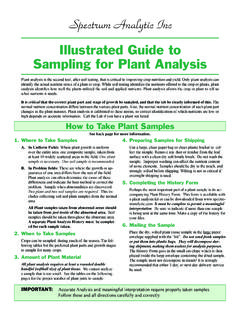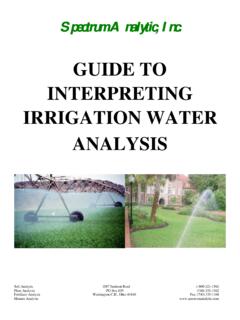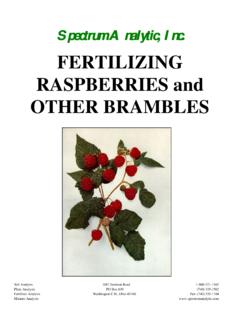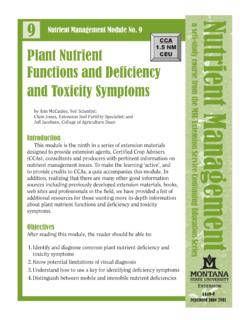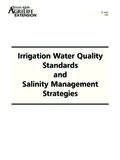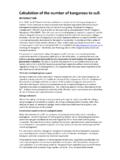Transcription of Illustrated Guide to Sampling for Plant Analysis
1 IMPORTANT: Accurate Analysis and meaningful interpretation require properly taken samples. Follow these and all directions carefully and Analysis is the second tool, after soil testing, that is critical to improving crop nutrition and yield. Only Plant Analysis can identify the actual nutrient status of a Plant or crop. While soil testing identifies the nutrients offered to the crop or plants , Plant Analysis identifies how well the plants utilized the soil and applied nutrients. Plant Analysis allows the crop or Plant to tell us what nutrients it needs.
2 It is critical that the correct Plant part and stage of growth be sampled, and that the lab be clearly informed of this. The normal nutrient concentration differs between the various Plant parts. Also, the normal nutrient concentration of each Plant part changes as the Plant matures. Plant Analysis is calibrated to these norms, so correct identification of which nutrients are low or high depends on accurate information. Call the Lab if you have a Plant not Where to Take Samples A. In Uniform Fields: Where Plant growth is uniform over the entire area, one composite sample, taken from at least 10 widely scattered areas in the field.
3 One Plant sample is necessary. One soil sample is recommended. B. In Problem fields: These are where the growth or ap-pearance of one area differs from the rest of the field. Plant Analysis can often determine the cause of these differences and indicate the best method to correct the problem. Sample when abnormalities are discovered. Two Plant and two soil samples are required. This in-cludes collecting soil and Plant samples from the normal area. All Plant samples taken from abnormal areas should be taken from just inside of the abnormal area.
4 Soil samples should be taken throughout the abnormal area. A separate Plant Analysis History must be complet-ed for each sample When to Take Samples Crops can be sampled during much of the season. The fol-lowing tables list the preferred Plant parts and growth stages to sample for many Amount of Plant Material All Plant Analysis requires at least a rounded double handful (softball size) of Plant tissue. We cannot analyze a sample that is too small. See the tables on the following pages for the proper number of Plant parts to Preparing Samples for Shipping Use a large, clean paper bag or clean plastic bucket to col-lect the sample.
5 Remove any dust or residue from the leaf surface with a clean dry soft bristle brush. Do not wash the sample. Improper washing can affect the nutrient content of some elements. Samples should be dry to the touch, and strongly wilted before shipping. Wilting is not as critical if overnight shipping is Completing the History Form Perhaps the most important part of a Plant sample is its ac-companying Plant History Form. This form is available with a Plant Analysis kit or can be downloaded from It must be complete to permit a meaningful interpretation.
6 Be sure to indicate if more than one sample is being sent at the same time. Make a copy of the history for your files. 6. Mailing the Sample Place the dry, wilted Plant tissue sample in the large paper envelope supplied with the kit . Do not send fresh samples or put them into plastic bags. They will decompose dur-ing shipment, making them useless for Analysis purposes. The History Form goes in the small envelope which is then placed inside the large envelope containing the dried sample. The sample must not decompose in transit!
7 It is strongly recommended that either 2-day, or next-day delivery service be to Take Plant SamplesSee back page for more Guide toSampling for Plant AnalysisCROPGROWTH STAGETO SAMPLEQUANTITYA lfalfaAt or prior to 5% bloomBarley, Oats,Rye, Wheat(other smallgrains exceptrice)a) Feekes Stages 3 through 9b) Feekes Stage 10 CanolaSeedling to VegetativeAt or prior to full bloomCorn(Field, Pop, andSilage)(a) Seedling (6 to 12 ) tall (< V6)(b) Prior to tasseling, (V7-VT)(c) Silk initiation to brown silk stage(R1-R5)Cotton(a) Seedling, 6 to 12 tall(b) Prior to or at first bloom(c) When first squares appearDiscard the (Petioles)When first squares appear to fullmaturityGrasses(Hay, Forage orPasture)Prior to headingPeanuts(a) Seedling stage(b) Vegetative to pegging stageRice(a) Seedling stage(b) Tillering(c) 1st Joint-Panicle Initiation(d) Panicle differentiation(e) Flowering-HeadingSoybeans(a) Seedling stage (V2 - V5)(b) Vegetative to early pod fill (> V5)Sugar Beets(a) Seedling stage(b)
8 Vegetative stagesSugar Cane 2 Months to MatureSunflowers(a) Seedling stage(b) Vegetative to full bloomTobacco(a) Seedling (transplants, 2 wks.+)15 to 20 plants30 to 40 plants ,depending on size30 to 40 leaves20 to 30 leaves20 to 30 leaves15 to 20 plants10 to 15 leaves10 to 15 leaves15 to 20 plants15 to 20 leaves30 to 50 petioles25 to 30 plants15 to 20 plants20 to 30 leaves15 to 20 plants15 to 20 plants20 to 30 leaves15 to 20 leaves20 to 30 leaves15 to 20 plants20 to 30 leaves15 to 20 plants10 to 20 leaves15 to 25 leaves15 to 20 plants15 to 20 leaves15 to 20 plantsAGRONOMIC and FORAGE CROPSE ntire above ground portion of Plant ortop 6.
9 Whichever is above ground portion of mature, or Flag plantFully developed leaves on upper portionof plantEntire above ground portion of fully developed leaf below above ground portion of plantYoungest fully mature leaves from themain stem of Plant . Petioles from the youngest fully matureleaves on the main stem of above ground portion of Plant ortop 6 , whichever is above ground portion of above ground portion of above ground portion of Leaf / Flag LeafY Leaf / Flag LeafY Leaf / Flag LeafEntire above ground portion of above ground portion of fully mature leaf in the fully mature leaf without above ground portion of above ground portion of fully mature leaf.
10 No fully mature leaf. No fully mature leaf. No PART(b) Vegetative stages10 to 20 leavesYoungest fully developed leaf from Pictorial Guide For More Plant Tissue Sampling TechniqueCROPGROWTH STAGEPLANT PARTTO SAMPLEQUANTITYA sparagus(a) Spears(b) FernsEntire above ground portion of mature frond (top 24 inches).10 to 20 spears10 to 20 frondsBeans(Field/Dry, Snap,Lima, etc.)(a) Seedling stage(b) Vegetative to early pod fillEntire above ground portion of fully mature leaf. No to 30 plants20 to 30 leavesBeets, Table Vegetative mature leaf in the to 50 leavesBroccoli,Cabbage,Cauliflower(a) Seedling stages(b) Vegetative to heading stagesEntire above ground portion of fully expanded wrapper to 30 plants15 to 20 leavesCarrots(a) Seedling stages(b)
